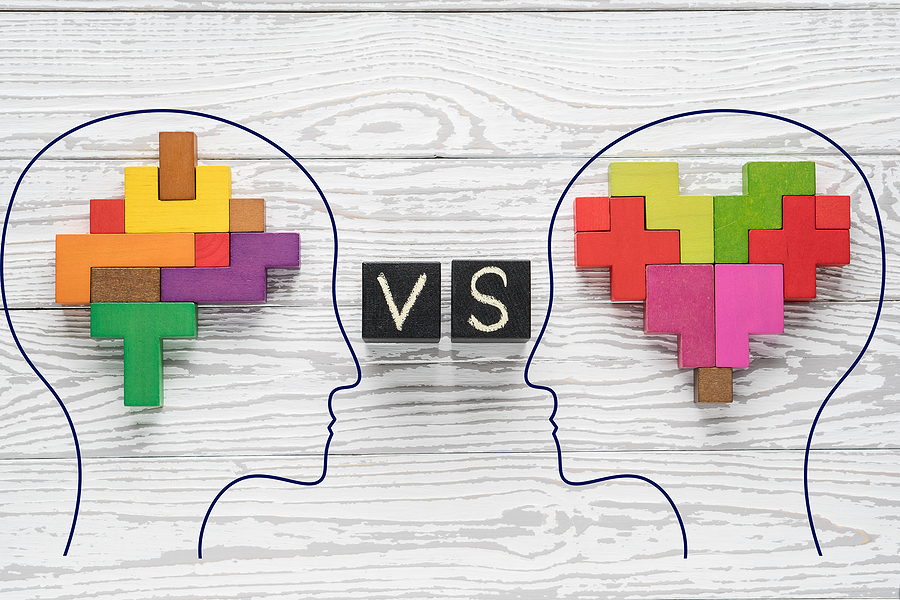Understanding the human being you’re talking to
People are not analytical, fact-based decision-making machines. We are feeling creatures who think, not thinking creatures who feel. It’s heart-over-head every time. Yet the vast majority of brand marketing outreach is based on a rational presentation of features and benefits.
The incredible formula.
The amazing ingredients.
How it’s faster, more efficient, less costly.
The shiny new food tech underneath.
But what if I told you that conscious thought does NOT inform the decisions consumers make. “For 50 years we’ve been using the wrong model. Emotional tugs trump rational pushes.” Dr. Robert Heath, Journal of Marketing Research
Uh oh.
Doesn’t matter what the product is either. Marketers are trained to serve up what they believe is the best, most logical, defensible and factually-compelling argument that can be made about why Brand X is better than Brand Y or Z. But this is upside down.
Here’s the essential truth as we know it: “Non-conscious intention produces both a conscious thought and action,” says Timothy Wilson, a Clinical Psychologist with the University of Virginia.
Ooh Kayy? So what does that mean?
The latest Neuroscience tell us why we’ve been unintentionally mis-managing marketing for a very long time. Turns out there are two brain systems at work in every person. System 1 is an effortless, always on, intuitive autopilot side of the brain. System 2 is the effortful, learning, rational, analytical side of the brain that unfortunately is inherently lazy. System 1 makes 98 percent of our decisions, leaving 2 percent for System 2 to ponder. Yes they work in tandem but System 1 is in charge.
Here is another way to understand the difference: System 1 can process 11 million bits of information per second. System 2 processes 40 bits of information per second. Gulp. Turns out the intuitive side of our brain is a lot smarter than we ever knew. That hunch or gut feel you had is probably right!
The impact on marketing best practices
System 1 responds to emotion because it uses emotion. Here’s how to think about it.
- Acts without deliberate analysis
- Generates our impressions, feelings and inclinations
- Exerts powerful influence on choices and judgments
- Drives the options we choose and originates the actions we take
Here are six essential ingredients for optimizing marketing outreach that track with what we now know about how people really operate and handle decisions.
- Exposure: we automatically assign superiority to what is familiar. Communicating sticky, memorable phrases and ideas is a good thing.
- Proof: we are drawn to prefer products and brands other people like and endorse.
- Positive feelings: if we feel good about a brand, we assume it possesses an abundance of beneficial qualities.
- Actions: people respond more readily to what you do more so than what you say. Brand experiences can show your heart.
- Reciprocity: we are hard wired to reciprocate in kind when faced with clear generosity. Surprise and delight is more than a catch phrase.
- Art: we respond well to artistic expression. How you use words, visuals, sounds and style matter.
The case for deeper brand meaning
Here at Emergent we’ve been talking about the importance of Higher Purpose to brand growth for years. On one level, Higher Purpose marketing is respectful of the fact that purchases are largely symbolic these days, a form of signaling our values and beliefs to others around us. Thus, Purpose creates added value to the consumers’ perceptions. However, Higher Purpose is also part of this emotion-driven eco-system that informs how people behave and take action.
“Science now proves what brand
strategists have always sensed. We
human beings have a need to believe in
and act upon something that’s greater than
ourselves… Let’s realize the significance
of this discovery and impress upon
everyone that a brand is a belief system.
Want greater rewards? Then impart your
brand with deeper meaning…” – Emergent
Give consumers something they can believe in – advocate for – that reflects their values and beliefs. This is how you create a community of ambassadors who will spread the good word about your brand and business. Transactional relationships between brands and users are a thing of the past. Your brand value proposition should extend beyond the product itself. It also fits snugly with our understanding of how to communicate successfully to System 1.
If you have more questions about how this revelation might impact your go-to-market plans, use this link to start an informal conversation.
Looking for more food for thought? Subscribe to the Emerging Trends Report.
Bob Wheatley is the CEO of Chicago-based Emergent, The Healthy Living Agency. Traditional brand marketing often sidesteps more human qualities that can help consumers form an emotional bond. Yet brands yearn for authentic engagement, trust and a lasting relationship with their customers. Emergent helps brands erase ineffective self-promotion and replace it with clarity, honesty and deeper meaning in their customer relationships and communication. For more information, contact [email protected] and follow on Twitter @BobWheatley.
